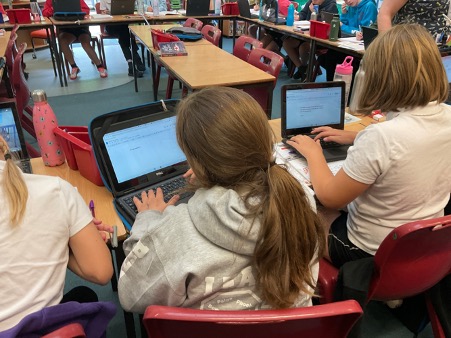Visit 2 Activity 6
Writing the climax and resolution on GoogleDocs
10:50- 12:30
Context: children come back from break and take their place in the classroom. Before they continue their writing activity where they left off, the teacher explains writing a resolution to the story. The teacher needs to leave the classroom for a short while, the TA takes over the lesson at this point. The children finish the lesson typing up their stories in GoogleDocs, to allow others to read their work.
Key activities
- Children will continue writing their stories, in particular the climax
- Children who are finished writing the climax to their stories will continue with writing the resolution
- Examples of narratives are presented in class
- Children who are finished with drafting their stories on paper, can type their stories into GoogleDocs
- Children with SEND use ScribEasy to finish their stories
- to write a climax using short, snappy sentences
- to write the ending of a narrative
- IWB
- Chromebooks with:
- Thesaurus
- Padlet
- Film
- GoogleDocs
- ScribEasy on laptop
- Independent writing
- Independent application of skills learned
- Presentation of narrative writing
- Reading aloud
- Asynchronous collaboration
- Face to face informal collaboration
- Writing a narrative text using grammatical and spelling conventions
- Making vocabulary choices that help build up suspense and action
- Using specific vocabulary to personalise the story
- Using dictionary and thesaurus to help craft the narrative
- Reading aloud
- Presenting narrative writing strategies and decision making
- Does the technology help support sharing children’s writing?
- Does the technology help support the writing process of children with SEND?

Lesson Commentary
Developing vocabulary to propel the action
The teacher restarts the lesson by explaining how to write the resolution, for those children who have already finished writing their climax. The IWB shows an example of a resolution.
- The IWB allows for immediate sharing of digital writing, and children can read along with the story being read aloud.
- Specific programmes may allow children with SEND, through prompting, multimodal resources and writing support,
- These support programmes can allow children who would not normally be able to participate fully in extended writing activities, to share their work with the rest of the class.
- New software allows children to take on a very visible role of expert
- GoogleDocs and GoogleDrive allows for sharing of children’s work and asynchronous collaborative writing
- Being prepared to learn alongside children in the classroom when new technologies are introduced
- How to set up shared folders and accounts for children to enable the sharing of work with others or ask IT support staff to set this up
- Have clear online and computer safety procedures, as well as policies to prevent online bullying to allow children to comment on other’s work online
- How to stream children’s screens to the IWB
